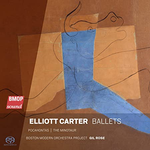|
Back
04/06/2021
“Elliott Carter: Ballets”
Elliott Carter: Pocahontas [1] – The Minotaur [2]
Boston Modern Orchestra Project, Gil Rose (conductor)
Recording: Jordan Hall, Boston, Massachusetts (May 10, 2019 [1] and January 11, 2020 [2]) – 65’57
BMOP/sound 1077 – Booklet in English

   
American composer Elliott Carter’s final work, Epigrams, was performed after his death at age 104, in 2012. The week of his death, pianist Pierre-Laurent Aimard was in Philadelphia with his concert tour of Debussy piano repertoire. For his encore he added a piano solo from Epigrams, and he spoke to Carter’s brilliant artistry. Carter is, or course, now recognized as one of the most accomplished American composers of the 20th century. The Boston Modern Orchestra Project’s (BMOP) latest new recording of Carter’s two ballet scores – Pocahontas (1938) and The Minotaur (1947) – were both considered failures when they premiered.
The BMOP was founded in 1996 by conductor Gil Rose, the 90+ musicians performing repertory focused on contemporary orchestral music for full orchestra. There has only been one recording of Pocahontas previous to this, and the BMOP rescues both Carter ballets that are distinctive for their progressive American orchestral flare.
As BMOP demonstrates, these ballets scores are more than footnotes in Carter’s musically daring early career. During this period was Carter’s four large orchestral works including his First Symphony. In his biography of Carter, musicologist David Schiff observes that in form and style these works “could have been written by four different composers”.
Before they established The New York City Ballet, Lincoln Kirstein and George Balanchine were co-founders of Ballet Society. In the 30s, after a late professional start, Carter was trying to kick-start his music career by accepting a commission to write a score for Pocahontas from his Harvard classmate Lincoln Kirstein as part of an American Theme series that Kirstein was touring the following year. The ballet was choreographed by noted dancer Lew Christensen. Paired on a program with Aaron Copland’s Billy the Kid which The Times dance critic John Martin reported was ‘warm and human’, and dismissed Carter’s score as “modernistic”, adding onus by describing it as “so thick it is hard to see the stage through it”.
Pocahontas tells the fated love story of the Pocahontas and Captain John Smith, a tale of forbidden love between a white man and a Native-American Princess. The historical lore is rich with the lessons of racial tolerance that may have been ignored in messaging, clinging to racism in all of its manifestations.
Meanwhile, the symphonic, rhythmic drive and chamber music clarity is entirely conducive to ensemble choreography of the era. It is no surprise that the BMOP wanted to revive this score on its musical merits. For starters, it has orchestral structures that become Carter signatures in the composer’s later compositions. And there is structural fusion in Pocahontas that is conventional on the narrative surface, a literalness of classic story ballets, but the sub streams of dissonance, irregular rhythms and delicate chromatic elements.
The Minotaur is stylistically completely different than Pocahontas. Premier choreographer George Balanchine and Carter collaborated on the dance libretto, but Balanchine opted out when he was vying to become director of The Paris Opera Ballet and the choreography was completed by his assistant, John Taras. The reception to the ballet may have been very different if Balanchine, with his clout, had followed through on bringing it to the stage...The Minotaur now strikes as a missed opportunity for Balanchine’s neoclassical imprimatur.
Carter’s compositional allegory of The Minotaur, and the symbolism of The Labyrinth traps Theseus until he is freed by Ariadne…the ‘building of the Labyrinth’ and the Bull devouring the Greek victims symbolizing the human atrocities of the Nazi concentration camps.
The score’s theatrical arc has more dimension than story ballet literalness, so common in story ballets. Carter’s atmospherics are more organic with more effects in line to the abstract symbolism of Stravinsky’s Apollo or Orpheus. Among the many dance scènes d’action, the rushing orchestral counterpoints in “Pasiphaë’s Dance with the Bulls” and the scorching ascending brass and propulsive percussion that tears through “The Fight of the Minotaur”.
Hearing ballet scores concertized is always instructive to the composer’s original technical aspects. Carter’s ambitious ideas are even more daring and its power in recorded performance with the symphonic thrust of this orchestra. Gil Rose masterfully calibrates the tempos for one, which in ballet productions can be easily distorted in the phrasing precision of the dancer. BMOP completely realizes the musical character of this mythic tale as allegory and the score’s solid, ambitious musicality.
Lewis J. Whittington
|